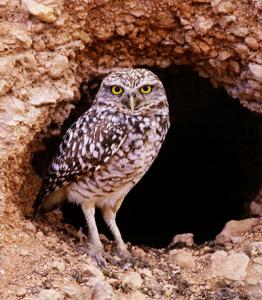Burrowing owls, diminutive raptors of the Athene cunicularia species, present a fascinating anomaly within the avian world. Unlike their arboreal counterparts, these owls have embraced a subterranean existence, carving out a niche in the ecological landscape with their peculiar lifestyle. This adaptation has led to a suite of unique characteristics and behaviors that distinguish them from other owl species. Prepare to delve into ten captivating facts about these ground-dwelling avians.
1. Masters of Subterranean Real Estate: The Borrowed Burrows
Contrary to popular belief, burrowing owls are not prodigious excavators. Instead, they are opportunistic inhabitants of pre-existing burrows. These subterranean dwellings are often the abandoned homes of prairie dogs, ground squirrels, badgers, or even tortoises. This commensal relationship highlights the owl’s reliance on other species for habitat provision. A prime example of resourcefulness, the burrowing owl secures shelter and nesting sites through this interspecies dependence. They will however, modify the burrows to suit their needs. They expand them and clean them, with both parents participating in this process.
2. A Diurnal Predilection: Daytime Hunters
While most owls are crepuscular or nocturnal hunters, burrowing owls exhibit a more diurnal behavioral pattern. They are frequently observed hunting during daylight hours, particularly during the breeding season when the demands of raising young necessitate increased foraging activity. This diurnal hunting strategy allows them to exploit a wider range of prey resources and minimize competition with nocturnal owl species. Look for them perched attentively outside their burrows, surveying their surroundings for potential meals. Their keen eyesight is adept at spotting movement, even at a distance.
3. A Cosmopolitan Distribution: From Prairie to Pasture
Burrowing owls boast a widespread distribution across the Americas, ranging from the grasslands of western North America to the pampas of South America. This broad geographic range reflects their adaptability to a variety of open habitats, including prairies, pastures, agricultural fields, and even urban areas. They thrive in areas with low vegetation and abundant burrowing mammals. Conservation efforts are crucial to maintaining suitable habitat for these adaptable birds across their diverse range.
4. An Eclectic Diet: A Voracious Appetite
The diet of a burrowing owl is remarkably diverse, encompassing insects, rodents, amphibians, reptiles, and even small birds. Their opportunistic feeding habits contribute to their resilience in varying environmental conditions. During the breeding season, insects often constitute a significant portion of their diet, providing a readily available source of protein for growing chicks. They are opportunistic feeders, readily adapting their diet based on prey availability and seasonal changes. They may even cache food near their burrows for later consumption.
5. A Singular Defense Mechanism: The Snake Impersonation
Young burrowing owls employ a unique defense mechanism to deter potential predators. When threatened, they mimic the sound of a rattlesnake, hissing and rattling their wings in a convincing imitation. This auditory illusion often startles predators, providing the owlets with a crucial opportunity to escape. This remarkable adaptation underscores the evolutionary pressures shaping their survival strategies. The sound is surprisingly realistic and effective in deterring predators.
6. The Art of Decoration: Burrow Adornment
Burrowing owls often decorate the entrance of their burrows with a variety of materials, including animal dung, feathers, and other debris. The function of this behavior remains a subject of scientific debate, but hypotheses include attracting prey, masking the scent of the burrow, or signaling occupancy to other owls. Regardless of the precise purpose, this peculiar habit adds to the mystique surrounding these captivating birds. These adornments might also play a role in regulating the temperature and humidity within the burrow.
7. A Symbiotic Relationship: Burrow Sharing with Snakes
Although seemingly counterintuitive, burrowing owls have been known to cohabitate with snakes within the same burrow system. These uneasy alliances are often driven by the shared need for shelter and protection. While the owls primarily target small rodents and insects, the snakes may prey on other burrow inhabitants, potentially offering a form of indirect protection to the owl family. This complex interspecies dynamic highlights the intricate web of relationships within the burrow ecosystem.
8. Monogamous Bonds: A Lifelong Commitment
Burrowing owls are generally monogamous, forming pair bonds that can last for several years. Both parents participate in the incubation of eggs and the rearing of young, demonstrating a strong commitment to their offspring. This cooperative breeding strategy increases the chances of successful reproduction and contributes to the overall stability of the population. Their parental dedication is remarkable to observe in the wild.
9. A Decreasing Population: Conservation Concerns
Burrowing owl populations have declined in many areas due to habitat loss, pesticide use, and collisions with vehicles. Conservation efforts are crucial to protecting these unique birds and ensuring their long-term survival. Habitat restoration, responsible pesticide management, and the installation of artificial burrows can help to mitigate the threats facing burrowing owl populations. Awareness and education are also key components of effective conservation strategies. It is essential to minimize the impact of human activities on their natural habitat.
10. Vocalizations: A Diverse Repertoire
Burrowing owls possess a wide range of vocalizations, including hoots, barks, coos, and chatters. These calls serve various purposes, such as communication between family members, territorial defense, and courtship displays. Their vocal repertoire is surprisingly complex for such a small owl. Listening to these sounds can provide valuable insights into their behavior and social interactions.
